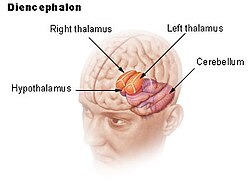
Back دماغ بيني Arabic Diencéfalu AST Ara beyin Azerbaijani Прамежкавы мозг Byelorussian Međumozak BS Diencèfal Catalan نێوانەدەماخ CKB Mezimozek Czech Mellemhjerne Danish Zwischenhirn German
| Diencephalon | |
|---|---|
 The hypothalamus and the right and left halves of the thalamus are labeled. The cerebellum is not part of the diencephalon. | |
| Details | |
| Precursor | Prosencephalon, derived from the neural tube |
| Part of | Human brain |
| Parts | Thalamus, the hypothalamus, the epithalamus and the subthalamus |
| Identifiers | |
| Latin | diencephalon |
| MeSH | D004027 |
| NeuroLex ID | birnlex_1503 |
| TA98 | A14.1.03.007 A14.1.08.001 |
| TA2 | 5661 |
| TH | H3.11.03.5.00001 |
| FMA | 62001 |
| Anatomical terms of neuroanatomy | |
In the human brain, the diencephalon (or interbrain[1]) is a division of the forebrain (embryonic prosencephalon). It is situated between the telencephalon and the midbrain (embryonic mesencephalon). The diencephalon has also been known as the tweenbrain in older literature.[2] It consists of structures that are on either side of the third ventricle, including the thalamus, the hypothalamus, the epithalamus and the subthalamus.
The diencephalon is one of the main vesicles of the brain formed during embryogenesis. During the third week of development a neural tube is created from the ectoderm, one of the three primary germ layers. The tube forms three main vesicles during the third week of development: the prosencephalon, the mesencephalon and the rhombencephalon. The prosencephalon gradually divides into the telencephalon (the cerebrum) and the diencephalon.
- ^ "Interbrain | anatomy". Encyclopedia Britannica. Retrieved 2021-05-07.
- ^ Cloake, P (August 1927). "The Influence of the Diencephalon ('Tween Brain) on Metabolism". Proceedings of the Royal Society of Medicine. 20 (10): 1643–56. doi:10.1177/003591572702001036. PMC 2100946. PMID 19986038.
© MMXXIII Rich X Search. We shall prevail. All rights reserved. Rich X Search